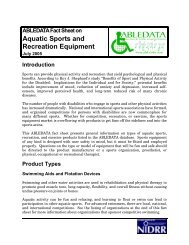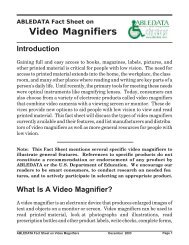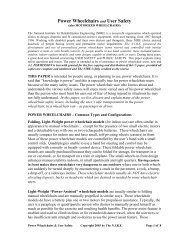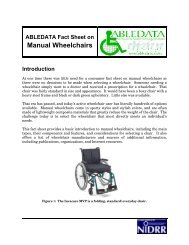Power Wheelchairs and Residential Fire Safety - AbleData
Power Wheelchairs and Residential Fire Safety - AbleData
Power Wheelchairs and Residential Fire Safety - AbleData
Create successful ePaper yourself
Turn your PDF publications into a flip-book with our unique Google optimized e-Paper software.
features, which should be tested with the user <strong>and</strong> be approved by an<br />
occupational therapist..<br />
5) Traversing INCLINES – Always steer UP or DOWN an incline.<br />
NEVER travel across an incline ... because the wheelchair is likely to fall<br />
over sideways - if you do. For wheelchairs with casters in front, avoid<br />
areas in the pavement or path that tilt to one side to avoid having the<br />
wheelchair roll off the path <strong>and</strong> over an embankment.<br />
6) Avoiding GROUND OBSTACLES to Wheels ... such as stones, cracks,<br />
curbs, etc. which must be seen <strong>and</strong> avoided by the wheelchair user to<br />
prevent sudden deflection of the chair to one side, off the path.<br />
7) BATTERIES should be Fully Charged before leaving home. It is<br />
dangerous to be str<strong>and</strong>ed outdoors in a power wheelchair with dead<br />
batteries. Periodically, the batteries should be checked by a technician for<br />
physical condition, cable connections <strong>and</strong> remaining charge capacities.<br />
8) <strong>Power</strong> wheelchair Users often have a CELL PHONE ... for safety.<br />
People with impaired h<strong>and</strong> dexterity, unable to operate a st<strong>and</strong>ard cell<br />
phone, can have a cell phone attached to the wheelchair that is modified<br />
for use by even a quadriplegic. If you cannot afford monthly cell phone<br />
fees, then get a “911-only” cell phone for which there are no monthly<br />
charges. Cell phones should be wired to work from both internal battery<br />
<strong>and</strong> wheelchair battery. Electrical noise filters may be needed to suppress<br />
motor noise. Wiring should be “fire-safe”.<br />
9) <strong>Power</strong>ed VENTILATOR Users should have a separate rechargeable<br />
battery on the wheelchair, for the ventilator. This assures that the<br />
ventilator will not fail even if the power wheelchair battery is exhausted.<br />
There should be an audible alarm device <strong>and</strong> the chair should have a cell<br />
phone or a 911 phone.<br />
10) Avoid RAIN <strong>and</strong> SNOW which are especially hazardous to power<br />
wheelchair users, <strong>and</strong> to the expensive equipment. Try to stay out of<br />
falling rain or snow; try to stay off wet, slippery surfaces coated with rain<br />
or snow. If you must travel in rain or snow, use a wheelchair van.<br />
11) When being TRANSPORTED in a Wheelchair Van always make<br />
certain that: (a) the wheels of the wheelchair are locked to the floor of the<br />
van; (b) that the wheelchair undercarriage or seat is tightly strapped down<br />
to the floor. (c) that the user is strapped DOWN to the seat – <strong>and</strong> BACK ,<br />
from the chest to the seat’s back structure. Countless wheelchair users<br />
have been thrown forward, out of their chairs, into the windshield <strong>and</strong> to<br />
their deaths because they did not follow these precautions. These must<br />
apply whether the van is privately owned, rented or a public for-hire<br />
service vehicle.<br />
12) Outdoor STAIR-CLIMBING <strong>Wheelchairs</strong>. Outdoor steps are usually<br />
wider, deeper <strong>and</strong> shallower than inside steps, <strong>and</strong> often of shorter height.<br />
<strong>Power</strong> <strong>Wheelchairs</strong> & <strong>Fire</strong>-<strong>Safety</strong> Copyright 2004 by The N.I.R.E. Page 6 of 7







